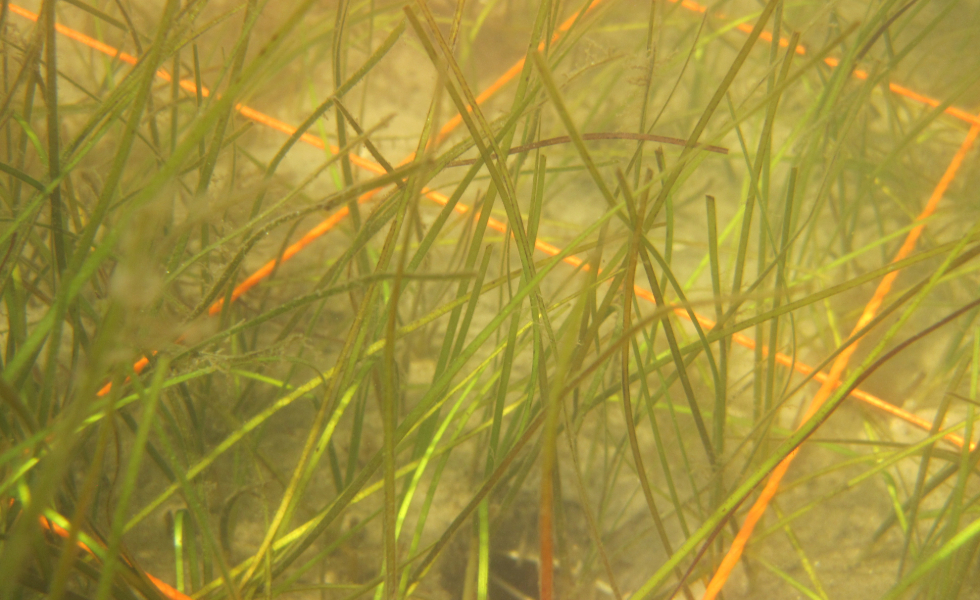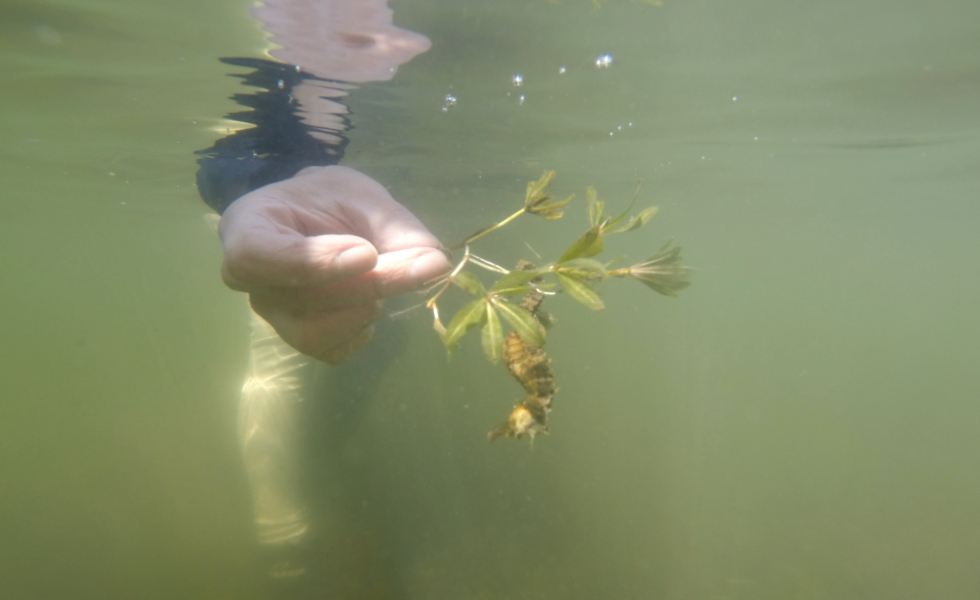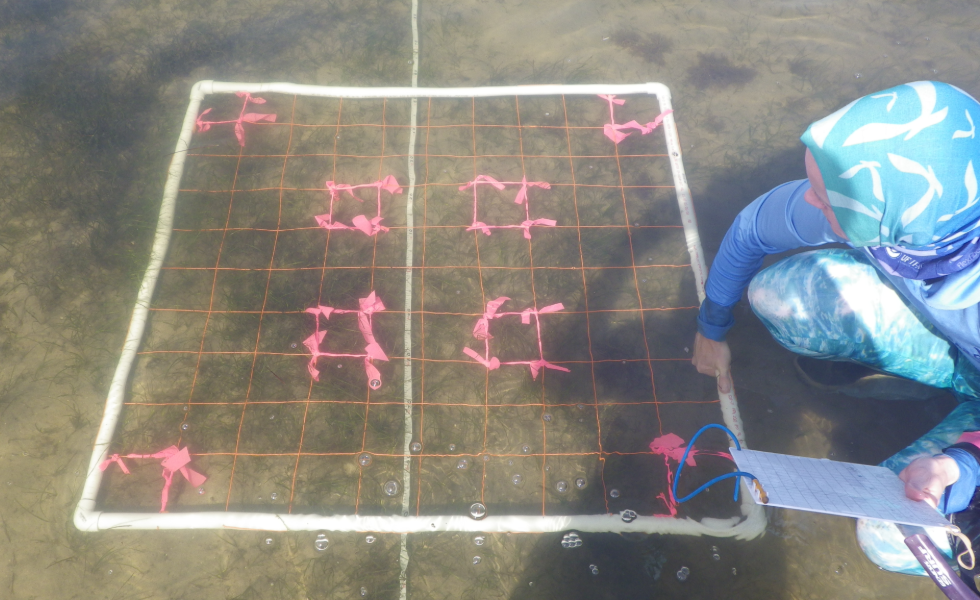Ella Armbruster is an undergraduate student the University of Florida, majoring in environmental science and minoring in zoology. Armbruster was selected as the 2025 Florida Sea Grant Community Engaged Intern (CEI). Sea Grant’s CEI program aims to broaden participation in marine and coastal professions by providing training and mentorship to undergraduate students.
Crossing over the Indian River Lagoon to Merritt Island, Max Brewer Bridge is a typical hot spot for locals and tourists to watch rocket launches from Cape Canaveral. Hundreds of viewers line the bridge to watch the regular launches out of our atmosphere. Yet, most are unaware of the spectacle beneath in the lagoon itself. On either side of the bridge, just off the shore of Merritt Island, lies two seagrass survey sites. Florida Sea Grant UF/IFAS Extension Agents Lisa Krimsky and Holly Abeels began surveying these sites twice a year back in 2022.
 The Indian River Lagoon is an estuary stretching 156 miles down the east coast of Florida; it is an incredibly biodiverse environment, with a large portion of that biodiversity stemming from the seagrass present throughout the lagoon. The estuary is considered the nursery of the ocean, with baby sea creatures of all kinds living out their early days within the lagoon.
The Indian River Lagoon is an estuary stretching 156 miles down the east coast of Florida; it is an incredibly biodiverse environment, with a large portion of that biodiversity stemming from the seagrass present throughout the lagoon. The estuary is considered the nursery of the ocean, with baby sea creatures of all kinds living out their early days within the lagoon.
Seagrass supplies food and shelter just as any nurturing parent would. Seagrass not only provides protection for marine juveniles, but it also helps protect our shorelines. Seagrass acts like a net across the lagoon floor, trapping sand and preventing erosion of our coasts. They also act like filters, similar to oysters, keeping our water clean and clear for the organisms that live there. Additionally, seagrass provides economic services as well, with each acre of seagrass valued at $20,255 each year, adding up statewide to approximately $44.6 billion annually through their support for commercial and recreational fisheries in the state of Florida.
For seagrass to thrive and provide its essential services, several key factors must be maintained. There are seven different species of seagrass throughout Florida, all with varying ranges of salinity they can exist in. Salinity in the Indian River Lagoon fluctuates depending on the release of freshwater from inland sources. Large-scale seagrass die-offs have also been linked to water temperature being too high, as well as sunlight being blocked by algae blooms. Algal blooms occur when excessive nutrients are added to waters that do not require them, resulting in an overgrowth of algae. Nutrient increases typically occur in Florida due to fertilizer runoff from agricultural areas. During blooms, sunlight has trouble penetrating the ocean surface, making photosynthesis for seagrass excessively difficult and possibly causing large die-offs.
 When Abeels and Krimsky first began surveying the Max Brewer Bridge locations, there was very little to report. The surveys were short and relatively easy due to a lack of seagrass present, allowing them to do both sides of the bridge in one day. “When we first started monitoring these two sites we were excited to find a blade or two of seagrass. It was barren. Then in 2024 we started to see large patches of Caulerpa, a fast growing macroalgae. As we observe large expanses of shoal and star grass, we are seeing so much more life within these areas including lots of small fish, crabs, and even a seahorse! It’s astounding how much has changed over four years and it is encouraging to see how resilient and responsive the lagoon is.” reflects Lisa.
When Abeels and Krimsky first began surveying the Max Brewer Bridge locations, there was very little to report. The surveys were short and relatively easy due to a lack of seagrass present, allowing them to do both sides of the bridge in one day. “When we first started monitoring these two sites we were excited to find a blade or two of seagrass. It was barren. Then in 2024 we started to see large patches of Caulerpa, a fast growing macroalgae. As we observe large expanses of shoal and star grass, we are seeing so much more life within these areas including lots of small fish, crabs, and even a seahorse! It’s astounding how much has changed over four years and it is encouraging to see how resilient and responsive the lagoon is.” reflects Lisa.
This past month, I had the opportunity to join them on their summer surveys of the locations. It is now their fourth year surveying this location, and to say the seagrass is bouncing back would be an understatement. What used to be a one-day endeavor now has to be split into two separate survey days, one for each site, due to the drastic increase in seagrass.
We’re seeing expansive stretches of shoal and star grass return—and with them, a surge of life including lots of fish, crabs, and even seahorses! It’s astounding how much has changed over four years and it is encouraging to see how resilient and responsive the lagoon is.
Dr. Lisa Krimsky
 They survey the seagrass twice a year, once in the summer and once in the winter, using a transect, a large spool of measuring tape used to easily markate distances, and preplaced poles spaced out in 100 meter intervals from the shore. For the first 100 meters, a quadrat (a square made from pvc pipes and further divided into 100 squares using string) is placed every 5 meters. Within the quadrant, they measure the percentage of seafloor covered by seagrass, how much drift algae is present, the different species of seagrass present, etc..
They survey the seagrass twice a year, once in the summer and once in the winter, using a transect, a large spool of measuring tape used to easily markate distances, and preplaced poles spaced out in 100 meter intervals from the shore. For the first 100 meters, a quadrat (a square made from pvc pipes and further divided into 100 squares using string) is placed every 5 meters. Within the quadrant, they measure the percentage of seafloor covered by seagrass, how much drift algae is present, the different species of seagrass present, etc..
A part of their survey includes determining the end of the seagrass bed, essentially how far from the shore the seagrass extends. This metric is now almost impossible to find, as the seagrass continues over six hundred meters offshore in one of the locations and a boat had to be used to scope out the full reach of the seagrass bed.
As it was my first time observing the seagrass in this location, I had to put it into perspective that four years ago, none of this seagrass was here. The amount of ocean life was also astounding; there were points where I feared getting hit by jumping baby mullet!
However, the health of seagrass in the Indian River Lagoon will always be a concern, now more than ever, with the looming effects of climate change. With the Florida Sea Grant’s Eyes on Seagrass program, you can get involved with citizen science efforts to map seagrass through the lagoon. The program holds month-long blitzes to encourage data submissions from anyone out on the lagoon with a phone to submit presence and absence reports, along with pictures, and any additional observations. Data submitted is used to map seagrass throughout the Indian River Lagoon and gauge seagrass health.
More more information on how to get involved with the Indian River Lagoon Eyes on Seagrass Bltiz, visit here for further resources: https://www.flseagrant.org/citizenscience/eyes-on-seagrass/eyes-on-seagrass-in-the-indian-river-lagoon-blitz-spring-2025/.